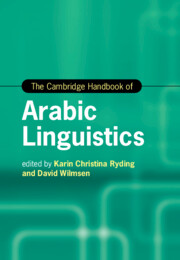Book contents
- The Cambridge Handbook of Arabic Linguistics
- Cambridge Handbooks in Language and Linguistics
- The Cambridge Handbook of Arabic Linguistics
- Copyright page
- Contents
- Figures
- Tables
- Notes on Contributors
- Acknowledgements
- Abbreviations
- Introduction
- Part I Arabic Applied Linguistics
- 1 Arabic Applied Linguistics
- 2 Language Planning in the Arab World in an Age of Anxiety
- 3 The Study of Arabic Language Acquisition
- 4 Issues in Arabic Language Testing and Assessment
- 5 Arabic Study Abroad
- 6 Models of Arabic Pronunciation
- Part II Arabic Variation and Sociolinguistics
- Part III Theoretical and Descriptive Studies
- Part IV Arabic Computational and Corpus Linguistics
- Part V Arabic Linguistics and New Media Studies
- Part VI Arabic Linguistics in Literature and Translation
- Index
- References
5 - Arabic Study Abroad
Critical Contextualization and Research-Based Interventions
from Part I - Arabic Applied Linguistics
Published online by Cambridge University Press: 23 September 2021
- The Cambridge Handbook of Arabic Linguistics
- Cambridge Handbooks in Language and Linguistics
- The Cambridge Handbook of Arabic Linguistics
- Copyright page
- Contents
- Figures
- Tables
- Notes on Contributors
- Acknowledgements
- Abbreviations
- Introduction
- Part I Arabic Applied Linguistics
- 1 Arabic Applied Linguistics
- 2 Language Planning in the Arab World in an Age of Anxiety
- 3 The Study of Arabic Language Acquisition
- 4 Issues in Arabic Language Testing and Assessment
- 5 Arabic Study Abroad
- 6 Models of Arabic Pronunciation
- Part II Arabic Variation and Sociolinguistics
- Part III Theoretical and Descriptive Studies
- Part IV Arabic Computational and Corpus Linguistics
- Part V Arabic Linguistics and New Media Studies
- Part VI Arabic Linguistics in Literature and Translation
- Index
- References
Summary
This chapter provides a critical examination of Arabic study-abroad numbers and outcomes, of recurrent problems, and of research-based interventions. Trentman’s study highlights both qualitative and quantitative assessments of students’ skills before and after the study-abroad experience, especially in oral proficiency. Arabic sociolinguistic variation has long played a destabilizing role in proficiency gain, measurement, and accuracy, and the challenge of developing networks of informal, relaxed relationships with native speakers is raised and addressed. Also addressed are the less-noted ‘ideologies’ of study abroad that focus either on a ‘touristy’ intercultural experience or on an instrumental ‘orientalist perspective’ that discourages student engagement with local communities. Research interventions such as reflective practice and ethnography projects are discussed and evaluated as ways to raise the awareness and progress of study-abroad students.
- Type
- Chapter
- Information
- The Cambridge Handbook of Arabic Linguistics , pp. 106 - 126Publisher: Cambridge University PressPrint publication year: 2021



